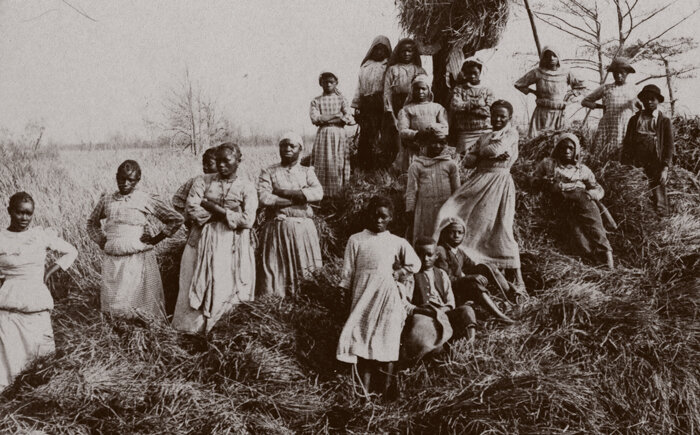Rice Culture
A rice raft with Gullah Geechee women, girlls, and boys off Sandy Island near Georgetown, S.C., in 1904. Photo: College of Charleston Stereoscopic Views, Special Collection, Addlestone Library.
Rice, Enslavement, and isolation
During the Trans-Atlantic Slave Trade, between the 16th and 19th centuries, more than 12 million Africans were put on the floating prisons we call slave ships and brought to the New World—North, Central, and South America. (Upwards of 2 million died during the Middle Passage from Africa to the Americas, making the Atlantic Ocean’s floor the largest graveyard, or crime scene, in the world.) Nearly 400,000 of the Africans forced into labor in the Americas ended up in the United States—an estimated 45 to 65 percent of them came through the Port of Charleston. (Historians estimate that more than 90 percent of all Americans of African descent can trace at least one ancestor to this area.) Many of these enslaved Africans remained in the South Carolina Lowcountry on rice, indigo, and cotton plantations concentrated in and around the cities of Georgetown, Charleston, and Beaufort. The South Carolina coastal plain was the most densely enslaved area in the southern United States.
The Gullah Geechee people are the descendants of Africans who were enslaved on these plantations in coastal Carolinas, Georgia, and Florida—from Jacksonville, NC, to Jacksonville, FL. Many came from West and Central African countries—which includes Angola, Senegal, The Gambia, Guinea, Sierra Leone, Liberia, Togo, Benin, Ivory Coast, Ghana, Nigeria, and the Democratic Republic of Congo. The nature of their enslavement on isolated island and coastal and inland plantations created a unique culture with deep African roots that are clearly visible in the Gullah Geechee people’s distinctive arts, crafts, foodways, music, style of worship, dance, naming practices, and language.
Rice was queen before cotton was king
In the 1700s, British colonists in South Carolina believed that rice would grow well in the moist, semitropical land along the coastline. The problem was the plantation owners had no knowledge of or experience with the cultivation of a complex tropical crop like rice. But they did know about Africa’s “Guinea Coast,” where rice was grown and that’s why planters told slave traders to bring them Africans from this region because they were more likely to know how to plant, grow, harvest, and process this difficult, labor intensive crop that involves knowledge of hydroponics, engineering, astronomy, hydraulic structures like levees and dikes, and tides. Africans living in the floodplains of the inland Niger delta began domesticating African varieties of rice thousands of years ago.
Growing rice was back-breaking, dangerous, deadly work. The enslaved Africans had to remove huge cypress and gum trees, draining, clearing, and leveling immense wooded tidal swamps that were infested with poisonous snakes, rats, alligators, and disease carrying insects. They created vast coastal marine estuaries with rough tools, constructing massive water management systems—dams, levees, dikes, canals, and floodgates—used to divert the massive amounts of river water needed to irrigate rice fields.
As the demand for rice grew, and the size of the plantations grew, so did the demand for Africans. Slaveholders were willing to pay higher prices for Africans from the Guinea Coast because the success of a rice growing operation was dependent on the farming and water management expertise of the enslaved Africans. Rice plantation owners got rich due to the stolen knowledge and labor of the enslaved. Some slaveholders referred to their plantations as “gold mines” because they could generate profit margins as high as 26 percent.
Rice was South Carolina’s first great agricultural staple. It made the South Carolina colony one of the richest of the 13 original colonies. It made Charleston one of the richest cities in the world during the Colonial and Antebellum periods. Indigo, cotton, forest products, and cattle ranching never came close to matching the riches that planters drew from their rice plantations. It made some of the planters millionaires. This lucrative cash crop dominated the Lowcountry's economy for almost 200 years, influencing almost every aspect of life in the region from the early 18th century to the early 20th century.
Most of the rice produced by South Carolina was grown in Georgetown County. In the end, more than 236,000 acres of land, some 160 miles of coastal South Carolina, was cleared by the Gullah Geechee’s ancestors to create the rice fields that ran from Georgetown and Horry counties to the South Carolina-Georgia border.
Sources
Seeds of Change: Five Hundred Years Since Columbus by Herman J. Viola and Carolyn Margolis
Carolina’s Gold Coast: The Culture of Rice and Slavery
African Passages, Lowcountry Adaptions
Long after its demise, a once-titanic rice industry continues to reshape S.C.’s Lowcountry
“There was more land moved to build these rice plantations than was moved to build the pyramids at Giza.”
